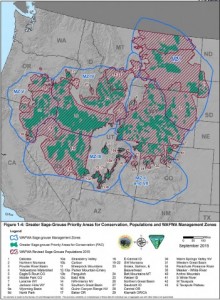The Interior Department announced this week that it would not add the Greater Sage Grouse to the endangered species list, and many westerners breathed a sigh of relief. To many, the decision sounded like a victory for state and local efforts to conserve a species without the heavy-handed regulatory approach that comes with a federal endangered listing.
Is the decision really a victory for the states? When we read the fine print and see what is really in store, it sounds more like we may have successfully jumped out of a sizzling frying pan and directly into the fire.
The feds decided not list the bird, but instead to implement a series of management plans covering vast tracts of BLM land. That includes regulations and prohibitions that closely mirror what would have happened with an endangered listing, but with a few differences that have many experts worried.
It is easy to understand why Interior Department officials balked at this listing. Remember that last November when they listed a smaller subspecies, the Gunnison Sage Grouse, they were promptly sued by the State of Colorado and several counties (including Mesa). The level of commitment to species conservation in that case was unprecedented. Coloradans invested well over $50 million of state, local, and private money in conservation easements to preserve ranchlands in the Gunnison Basin, preserving over 64,000 acres of open space, ranchlands, and grouse habitat over a 20-year period – all with the promise that such efforts would avoid an endangered listing. As Gunnison County’s superb legal filing points out, not once in all the meetings throughout those 20 years did the federal government ever hint that the program wasn’t good enough, or that any shortcomings might result in a listing anyway.The Interior Department is now faced with the embarrassing prospect of heading to court on the Gunnison Sage Grouse listing with an extremely weak case, and did not want a repeat with the more-widespread Greater Sage Grouse. In fact, the agency has ample evidence that the larger species population is not only widespread but has been increasing for at least a decade.
Nevertheless, as we have seen so many times before, the same federal officials seemed to be ignoring all those state and local conservation efforts, determined to list the Greater Sage Grouse, too – and to implement 15 new management plans covering 165 million acres in 11 western states. Faced with massive opposition and the threat of similar lawsuits, but also with similarly successful and popular state and local conservation efforts, Interior finally decided to forego the listing. But in reaching that decision, the Administration relied NOT on the state and local efforts, or all the money being spent on conservation, but rather on the new federal land management plans.
Those plans go well beyond what would normally happen with an endangered listing because they include restrictions not just on habitat occupied by the birds (or designated as potential habitat), but on “buffer zones” anywhere near. That means that human activity can be restricted on land that is, by definition, NOT identified as sage grouse habitat. On a swath of territory from Washington to Nevada and from Montana to Colorado, that could mean severe restrictions on energy and mineral production, forest restoration, grazing, hunting, and recreation. That is why the Western Energy Alliance is suggesting that these new management plans could cost the western economy as much as $7.7 billion and perhaps cause the loss of 31,000 jobs.
It is unclear, by the way, whether the BLM really has the legal authority to give the Fish and Wildlife Service such broad veto authority over land management – without an endangered listing. In other words, what authority does the Endangered Species Act give anyone, over anything, if there is no endangered species? The State of Utah is already headed to court on that question, just as surely as several national environmental groups are preparing to sue, still demanding the endangered listing. In the end, we might wind up with both these onerous management plans AND the listing. A cynic might almost wonder if that was the real objective all along.
Like so many other observers of federal land management, I hope managers will work with our communities, not against them. But I can’t help wondering if we may have dodged one bullet only to be felled by another. I hope that’s wrong, because it is nearly impossible to jump out of the fire and back into the frying pan.
(A version of this column appeared in the Grand Junction Daily Sentinel September 25, 2015)





Thank you! I’m so tired of reading day after day “It’s real!” “No it’s not!” “Yes it is!” “Idiot!” “Moron!” Sheesh!There are so many isseus. What they all come down to is the impact of so many people living a lifestyle that consumes so many resources. I think we need to find ways to reduce our numbers and our impact on the planet or there’s very little hope for our long-term survival. I hope we’re smart enough to figure it out before it’s too late.
Comments on this entry are closed.